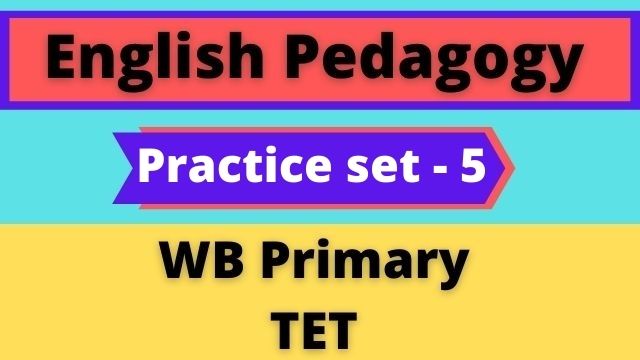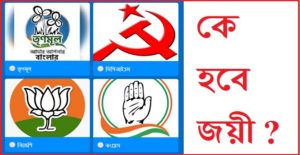
English Pedagogy – WB Primary TET Practice Set-5
- A child learns to make simple sentences and express his ideas by
A. 18 months
B. 2 years
C. 5 years
D. 7 years
Ans – A. 18 months
- Teaching and learning is a journey from—
A. Concrete to abstract
B. Simple to complex
C. Known to unknown
D. All the above
Ans- D. All the above
- When can a child learn how to use language creatively?
A. Right from birth
B. By the 2nd year
C. By 5 years, as they can create new sentences
D. By 7 years when they attain considerable expertise
Ans- D. By 7 years when they attain considerable expertise
- The method of teaching English adopted at present in school curriculum is
A. Formative Correlational Approach
B. Functional Communicative Approach
C. Function Corrective Approach
D. Figurative Comprehensive Approach
Ans- B. Functional Communicative Approach
- Why should a science teacher know the stages of language development?
A. Knowing language can also help them in their own job
B. Language teachers can explain better
C. Anyone can become language teacher
D. So that they can also help in improving language,as it plays an important role in learning
Ans- D. So that they can also help in improving language,as it plays an important role in learning
- FCA is in opposition to
A. Structural Approach
B. Comprehensive Approach
C. Translation and Grammar Method
D. Functional Approach
Ans- A. Structural Approach
- Suppose, both parents have English as their mother tongue, but the child is born in West Bengal. Then the child’s first language will be
A. Bengali
B. English
C. Gujrati
D. Marathi
Ans-. B. English
- Communicative Language Teaching replaced basically…
A. Natural Language Processing
B. Structural Teaching
C. Situational Language Teaching
D. Motivational Teaching
Ans- B. English
- One is born in France and have to deal in French; the father is a Bengali, the mother is a Korean and the individual likes studying Spanish. The second language of the individual is
A. French
B. Bengali
C.Korean
D. Spanish
Ans- D. Spanish
- Direct Method is also known as
A. Natural Method
B. Indirect Approach
C. Inductive Approach
D. All the above
Ans- A. Natural Method
- Why do we need to train students of our country in the skills of reading, writing, understanding and speaking,as far as English is concerned?
A. Speaking in English helps one to explain the lesson properly
B. To make students understand the lesson fast
C. English is easier than many languages
D. English is the official language of India; learning it will not only help them find better jobs but also enrich them in many different aspects
Ans- D.English is the official language of India; learning it will not only help them find better jobs but also enrich them in many different aspects
- Grammar- Translation Method stresses on
A. Accuracy
B. Fluency
C. Appropriateness
D. Listening Skill
Ans- A. Accuracy
- The first language which one learns is termed as the ‘first language’, the second language is the ‘second language’, the third language learnt is termed as the ‘third language’, and henceforth. Is it true?
A. No, the first language or primary language one learns is termed as the’first language’, but the other language which one learns is always the ‘second language’,
B. Yes, it is true as it appears logical
C. One may learn any number of language but it is always the ‘first language’, as he is studying that particular language for the first time
D. The first language which one learns is called official language
Ans- A. Accuracy No, the first language or primary language one learns is termed as the’first language’, but the other language which one learns is always the ‘second language’,
- Grammar- Translation Method is basically used to teach
A. Grammar
B. Foreign language
C. Rules of any language usage
D. Classical language
Ans- A. Accuracy
- Bilingualism and multilingualism are identical, as in these two situations the learner learns more than one language. Is it true?
A. Yes, it is true
B. Bilingualism and multilingualism have something in common as far as the learning of more than one language is concerned; but not identical as the first is more common and the latter is not
C. No, it is untrue
D. The logic is weak
Ans- B. Bilingualism and multilingualism have something in common as far as the learning of more than one language is concerned; but not identical as the first is more common and the latter is not
- The objective of Direct Method is —
A. To increase power of comprehension
B. To increase communicative power
C. To develop a command over the target language
D. To develop personality
Ans- C.To develop a command over the target language
- At what age do children start talking to one’s own self and stop talking loudly?
A. 1 year
B. 2 years
C. Middle age
D. 18 months
- Grammar- Translation Method does not
A. Encourage learning though mother tongue
B. Give importance to grammar
C. Enhance a student’s communicative skill
D. Enable the student too use the language fluently
Ans- C.Enhance a student’s communicative skill
- What are the important criteria for language development?
A. Good trainers and rich environment
B. No such criteria can be mentioned as language development happens on its own and is not conditional
C. Desire of the student to learn, ambience and also the teaching methodology
D. Only the desire of the student to learn
Ans- C.Desire of the student to learn, ambience and also the teaching methodology
- Traditional method goes against the
A. Prescriptive grammar
B. Simulation
C. Pedagogic principles
D. Generalization
Ans- C.Pedagogic principles
- What is the principal difference between acquiring and learning?
A. Both are same
B. In acquiring, student memories the language and in learning, student learns by imitating
C. Learning comes earlier and is followed by acquiring
D. Acquiring is natural to the environment but learning is conscious
Ans- D.Acquiring is natural to the environment but learning is conscious
- The incidental or Currelative Method is known as
A. Inductive
B. Deductive
C. Structural
D. Reference method
Ans- D.Reference method
- Which linguist commented on the difference between language acquisition and language learning?
A. Chomsky
B. Derrida
C. Stephen Krashen
D. N. Damodaran
Ans- C.Stephen Krashen
- Journey from example to generalization is
A. Inductive
B. Deductive
C. Incidental
D. All the above
Ans- A.Inductive
- Acquisition of any language does not involve learning of rules of the language in any formal setting. Is it true?
A. This is true, as language acquisition does not involve any conscious learning of language rules
B. The proposition is false
C. Language learning is similar to language acquisition
D. Formal setting is similar to language acquisition
Ans- A.This is true, as language acquisition does not involve any conscious learning of language rules
- Inductive method proceeds from
A. Heavy materials to light ones
B. Known to unknown
C. Simple to complex
D. Both b) & c )
Ans- D.Both b) & c )
- Language acquisition guarantees native-like expertise in the case of —-
A. First language
B. Second language
C. Mother tongue
D. Target language
Ans- A.First language
- Deductive method proceeds from
A. Law and rule to observation
B. Observation
C. Generalization to specification
D. Examples and illustrations
Ans- A.Law and rule to observation
- Language learning involves–
A. Learning only the rules of the languag
B. How to communicate with the peer- group
C. The ability to read and write properly
D. Learning of the rules of the language, having a conscious knowledge of grammar as well as vocabulary
Ans- D.Learning of the rules of the language, having a conscious knowledge of grammar as well as vocabulary
- One of the principales of materials preparation for language learning is that
A. Complex material should be chosen
B. Grading of materials should be done
C. Any kind of material can be chosen
D. A small amount of material should be introduced
Ans- B.Grading of materials should be done
- Which one of the following statements is correct?
A. First language is acquired, second language is learnt
B. Second language is acquired, first language is learnt
C. Both first and second language is learnt
D. It is yet to be proven linguistically
Ans- A.First language is acquired, second language is learnt
- Correct pronunciation of individual sound is related to
A. Accuracy
B. Fluency
C. Both accuracy and fluency
D. Neither accuracy nor fluency
Ans – A.Accuracy
- Do you think learning of second language involves confrontation between the reservoir of information of the first and second language?
A. Yes, this is true and it hinders the pace of second language learning
B. No, this is untrue and does not involve any confrontation
C. The entire proposition is illogical
D. The reservoir of information of second language overlaps that of the first language acquisition, because—-
Ans- A.Yes, this is true and it hinders the pace of second language learning
- Language accusation occurs only when
A. The child is through the rules of grammar
B. The child is given a reward
C. The child has exposure to the language
D. The child absorbs the language without conscious attention
Ans- C.The child has exposure to the language
- Teaching is more needed in second language learning, rather than first language acquisition, because—
A. More exposure in common in the case of first language but not in the issue of second language
B. Teaching is needed in both the cases and in same degree
C. Teaching is not essential in any of the cases
D. Intuition is important in both the cases
Ans- A.More exposure in common in the case of first language but not in the issue of second language
- When a child is asked to recite a poem, it can help the teacher to test
A. Knowledge of literature
B. Proficiency of speaking
C. Acting talent
D. Comprehension
Ans- D.Comprehension
- Less editing and checking is involved while teaching the first language but not in the case of second language. Is it true?
A. This is true as more exposure is natural in the case of first language acquisition and limited error correction is required
B. This is highly irrational
C. The same is true for second language learning
D. Teaching of any language involves the same procedure
Ans- A.This is true as more exposure is natural in the case of first language acquisition and limited error correction is required
- The structure ‘he goes to school’ is often produced by learners due to
A. Failure of intelligence
B. Mother tongue interference
C. Overgeneralization of rules
D. Wrong teaching
Ans- C.Overgeneralization of rules
- Motivation is extrinsic in second language learning but not in the case of first language acquisition. Is it true?
A. This is also true for first language acquisition
B. This is only true for second language learning
C. This is true for second language learning and also up to a limit in the case of first language acquisition
D. It is untrue for both the cases
Ans- C.This is true for second language learning and also up to a limit in the case of first language acquisition
- Study of meaning in a language is known as
A. Syntax
B. Semantics
C. Morphology
D. Linguistics
Ans- A. Syntax
- Which of the following stages should be adopted for effective second language learning?
A. Acquisition in the beginning followed by a balance between learning and acquisition; finally leading to emphasis on language learning
B. No a are involved
C. For effective learning, the students need to memories all the different a
D. Acquisition and learning go hand-in-hand
Ans- A.Acquisition in the beginning followed by a balance between learning and acquisition; finally leading to emphasis on language learning
- Where will you add disclosures in a letter?
A. Below the signature and the right side margin
B. Below the signature and the left side margin
C. Above the signature and the right side margin
D. Any of these
Ans- B.Below the signature and the left side margin
- Who is Skinner?
A. Football player
B. Driver
C. Linguist and propagator of behaviourist theory
D. English teacher
Ans-. C.Linguist and propagator of behaviourist theory
- Wile writing a notice, the writer should prefer
A. Active voice
B. Passive voice
C. Any voice
D. None of these
Ans- B.Passive voice
- What is LAD?
A. It is a device for language teaching
B. A natural faculty in the mind of any child which involves a natural predisposition to learn language and stands for Language Acquisition Device
C. It is a computer chip
D. This represents Language Achievement Device
Ans- B.A natural faculty in the mind of any child which involves a natural predisposition to learn language and stands for Language Acquisition Device
- Learning a language is a ….
A. Gradual process
B. First process
C. Instant process
D. All inclusive process
Ans- A.Gradual process
- What is the contention of Jean Piaget?
A. Language learning is automatic
B. Language is just one aspect of a child’s overall intellectual development
C. Language learning solely depends on ambience
D. Motivation is key to language learning
Ans- B.Language is just one aspect of a child’s overall intellectual development
- ‘REGISTER’ is….
A. Variety of language according to region in a particular country
B. Variety of language according to countries
C. Any of these
D. None of these
Ans- A.Variety of language according to region in a particular country
- The fourfold skill related to second language learning consists of—-
A. Reading, writing, grammar, rhetoric
B. Understanding, speaking, reading, writing
C. Listening, speaking, reading, writing
D. Understanding, listening, reading, writing
Ans- C.Listening, speaking, reading, writing
- ‘Phonetics’ is basically associated with
A. Sounds
B. Sentences
C. Grammar
D. Of all these
Ans- A.Sounds




